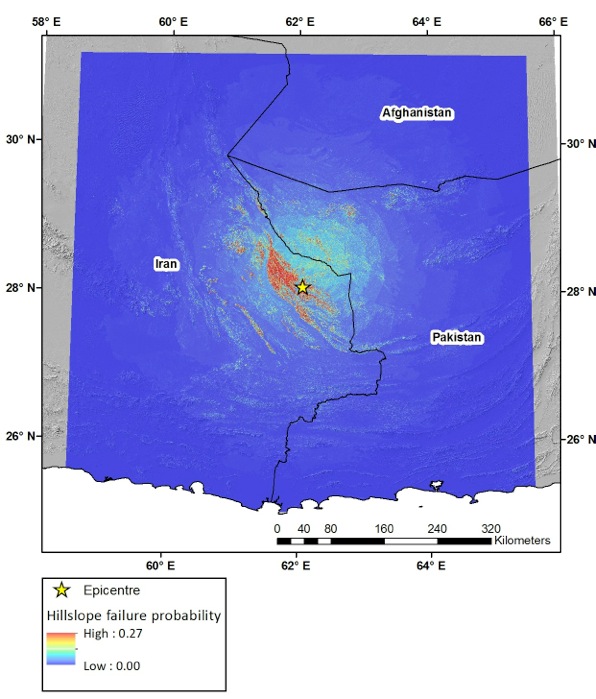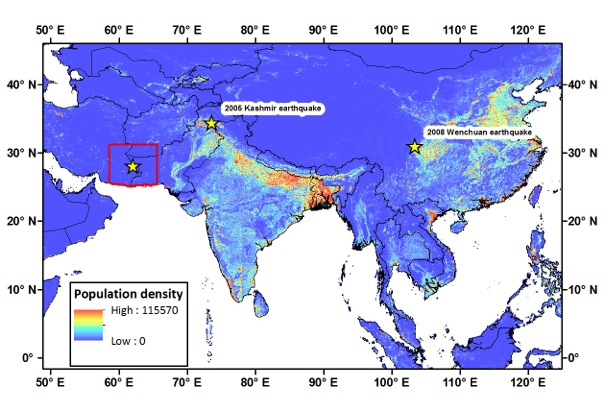18 April 2013
A first analysis of the potential landslide distribution from the Iran earthquake
Posted by Dave Petley
By Rob Parker (University of Cardiff) and Dave Petley
The Mw = 7.8 earthquake on Tuesday in Iran was the largest event in that country for about 50 years. Fortunately, the depth of the earthquake (82 km) and the low population density in the affected areas meant that loss of life was low for an event of this size. Indeed, reports suggest that only one person died in Iran, although there are reports of 40 deaths in Pakistan. This single fatality in Iran was the result of a landslide, and one of the images on the BBC reports about the earthquake also seems to show landslides:
Over the last three years or so, we have been working with our colleagues Alex Densmore and Nick Rosser, and funded by the Willis Research Network, to develop a model that will allow us to make an initial assessment of landslide impacts in earthquakes. Rob recently submitted his PhD, and has now moved to a post-doctoral position at Cardiff. However, we thought that this event would be an interesting first application of the model, which has been produced through a statistical (logistic regression) analysis of spatial patterns of landslides (with areas larger than 11,000 square metres) triggered by four large earthquakes in the USA, New Zealand, Taiwan and China. The model provides a first-order prediction of the probability of hillslope failure across the region affected by seismic shaking, based on the strength of ground motions and the gradient of hillslopes. Areas likely to have experienced high levels of landslide activity are shown in red, and while areas we expect to be less affected by landslides are shown in green and then blue. Here, landslide probability has been estimated using preliminary ground motion data published by the USGS and hillslope gradients derived from the ASTER global elevation model.
This is the outcome of the model:
We have a Google Earth kml of this map – you can download it from here.
Some notable features of the predicted landslide distribution are:
- The highest levels of landslide activity are predicted close to the epicentre, where ground accelerations were strongest;
- Higher landslide probabilities are predicted to the south-west of the epicentre, where there are higher levels of relief, and lower probabilities are predicted for lower relief regions to the north-east;
- Despite the high magnitude, the predicted impact of landslides is relatively low. This can be seen through a comparison of predicted landslide activity with that observed in other major earthquakes (see table below). By aggregating predicted probabilities spatially, the percentage of hillslopes that undergo failure can be estimated. Table 1 shows a comparison of the predicted percentage area affected by landslides within 20 km of the epicentre, with that observed in three other earthquakes. Although the Tuesday’s earthquake has a magnitude similar to the Wenchuan earthquake, the predicted density of landslides is lower than that observed in the magnitude 6.7 Northridge earthquake. This is mainly due to the deep focus of Tuesday’s earthquake, which meant that surface ground accelerations were weaker than those produced by shallower earthquakes of this size.
| Earthquake | Magnitude | Depth(km) | Percentage of failed hillslopes within 20 km of epicentre |
| 2008 Wenchuan earthquake (China) | 7.9 | 12.8 | 13.4 % (observed) |
| 2013 Khash earthquake (Iran) | 7.8 | 82 | 0.3 % (predicted) |
| 1999 Chi-Chi earthquake (Taiwan) | 7.6 | 8 | 1.1 % (observed) |
| 1994 Northridge earthquake (USA) | 6.7 | 18 | 0.5 % (observed) |
A notable feature of this earthquake is the relatively low number of reported deaths (41 in the two affected countries). The 2008 Wenchuan earthquake, which had a magnitude of 7.9 (i.e. it was similar to this event), caused around 80,000 fatalities, 20,000 of which were attributed to landslides. Similarly, the 2005 Kashmir earthquake in Northern Pakistan (magnitude 7.6) resulted in over 80,000 fatalities. Underestimates of damage and fatalities are common in the immediate aftermath of large earthquakes, particularly in remote areas, and the death toll may change over the coming days. However, the epicentral region has a relatively low population density compared with areas affected by the Wenchuan and Kashmir earthquakes:
Estimates from 2008 suggest a total population of around 4 million within the area covered by our landslide model above. The death toll is therefore unlikely to rise to the levels seen in Wenchuan and Kashmir, where population densities are much higher. It is this low population density, combined with the very large depth of the earthquake, that has meant that the loss of life is so low. A similar, but shallow, earthquake in a more densely populated area would have had very different outcomes.
It is of course vital to say that this is just a first order estimation, and we will need to examine the actual distribution as images become available.
Reference
Bright EA, Coleman PR, King AL, Rose AN, Urban ML. LandScan 2008. 2008 ed. Oak Ridge, TN: Oak Ridge National Laboratory; 2009.





 Dave Petley is the Vice-Chancellor of the University of Hull in the United Kingdom. His blog provides commentary and analysis of landslide events occurring worldwide, including the landslides themselves, latest research, and conferences and meetings.
Dave Petley is the Vice-Chancellor of the University of Hull in the United Kingdom. His blog provides commentary and analysis of landslide events occurring worldwide, including the landslides themselves, latest research, and conferences and meetings.